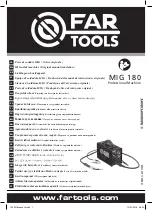
Welding procedure
TIG welding
099-00T400-EW501
21.10.2016
51
4.1.17 AC commutation optimisation
The AC commutation assistance function can help to increase process stability when welding materials
such as pure aluminium. If half-wave failures should occur during the welding process, the parameter can
be increased, counteracting half-wave failures.
The
parameter must first be switched on in the machine configuration menu
> see 4.7 chapter
. The
parameter value can then be selected and set in the Expert menu
> see 4.1.20 chapter
.
4.1.18 Simultaneous welding on both sides, synchronisation types
This function is important, if two power sources are used to simultaneously weld on both sides, as is
sometimes required for welding thick aluminium materials in the PF position. This ensures that, with
alternating currents, the positive and negative pole phases are present on both power sources
simultaneously, thus avoiding the arcs negatively influencing each other.
4.1.19 Synchronisation via mains voltage (50Hz / 60Hz)
Phase sequences and rotating magnetic fields in the supply voltages must be the same for both welding
machines. If this is not the case, the energy input into the weld pool will be negatively affected.
Some machine types can be optionally retrofitted with a rotary switch to set the phase position (ON
NETSYNCHRON). Use this rotary switch to correct the phase difference in increments of 60° (0°, 60°,
120°, 180°, 240° and 300°). Optimum phase correction will directly achieve better welding results.
The synchronisation via mains voltage function is enabled in the Expert menu (TIG). The parameter
must be set to
(signal light Netsync lights up)
> see 4.1.20 chapter
.
















































